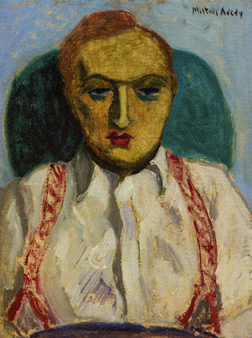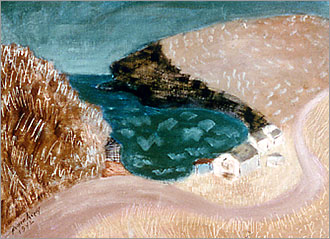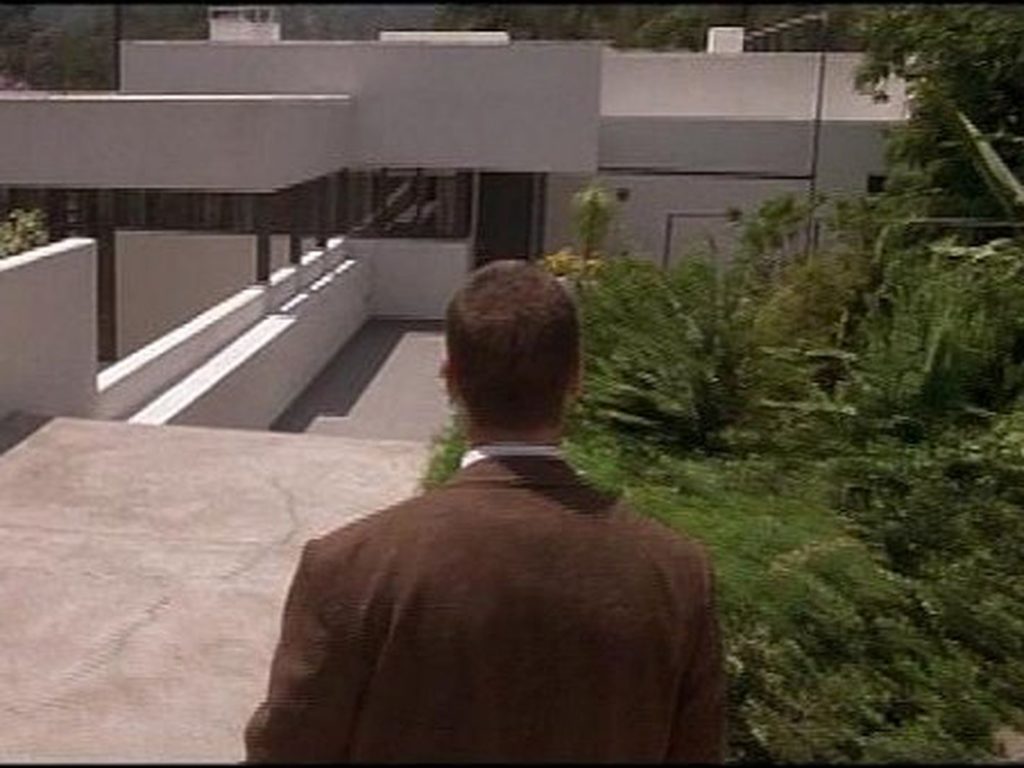In between plays Mrs. T and I have been tooling around Los Angeles and its environs, checking out art of various kinds. On Tuesday we fired up my Garmin StreetPilot c500 and set a course for Richard Neutra’s “Health House,” a legendary piece of mid-century modern domestic architecture that movie buffs will need no prompting to recognize as the residence of Pierce Patchett, the “powerful behind-the-scenes strange-o” of L.A. Confidential. It’s privately owned, so you can only view it from the street, but that’s a sufficiently cool thing to do if, like Mrs. T and me, you’re into modern houses. We then tooled over to Neutra Place, a quiet side street that is lined with nine separate Neutra houses, and spent a few minutes goggling.
On Wednesday we stopped by a less well known but equally interesting residence, the home of Annette Kaufman. Regular readers of this blog may recall my recent posting about Annette, the widow of Louis Kaufman, the great American violinist and art collector. Annette and I had lunch in New York two months ago, at which time she invited Mrs. T and me to visit her in Los Angeles. We accepted with alacrity.
From there the three of us went to the Getty Museum, where we had an excellent lunch and chatted happily about art and music. It was the first time in my life that I’ve taken part in a mealtime conversation in which one of the participants reminisced about Milton Avery and Bernard Herrmann. We then took a stroll through “Consuming Passion: Fragonard’s Allegories of Love,” a splendid little show that merely served to whet Annette’s apparently inexhaustible appetite for art, which we slaked by driving straight to the Armand Hammer Collection. After that we returned to her house and put our feet up for an hour while she returned a couple of dozen phone calls. Did I mention that Annette is ninety-three years old? I hope I’m a quarter as energetic as she is if I should be lucky enough to live so long. (I wish I were half as energetic as she is right now.)
 Annette lives in a house that Lloyd Wright, Frank’s son, designed for her and Louis in 1935. Though it looks nothing like the work of his famous father, it has the same clean and inviting interior lines that are familiar from Frank Lloyd Wright’s Usonian houses, and it is infinitely better suited to the display of art–a major consideration for the Kaufmans, who amassed a huge collection of paintings and sculpture in the course of their long life together. Annette has given much of their collection away since Louis’ death, but she still owns a goodly number of remarkable pieces, many of which were painted by Milton Avery.
Annette lives in a house that Lloyd Wright, Frank’s son, designed for her and Louis in 1935. Though it looks nothing like the work of his famous father, it has the same clean and inviting interior lines that are familiar from Frank Lloyd Wright’s Usonian houses, and it is infinitely better suited to the display of art–a major consideration for the Kaufmans, who amassed a huge collection of paintings and sculpture in the course of their long life together. Annette has given much of their collection away since Louis’ death, but she still owns a goodly number of remarkable pieces, many of which were painted by Milton Avery.
 The first thing you see when you open the door, for instance, is an Avery portrait of Louis wearing a pair of bright red suspenders. Stroll into the dining room and you’ll find “California Landscape/Seascape,” the 1942 painting that was one of the highlights of the Phillips Collection’s great 2004 Avery Retrospective. Beyond it in the breakfast nook is a brightly colored, strikingly Cézanne-like still life that the Kaufmans bought in 1926 for $25–the very first painting that Avery ever sold.
The first thing you see when you open the door, for instance, is an Avery portrait of Louis wearing a pair of bright red suspenders. Stroll into the dining room and you’ll find “California Landscape/Seascape,” the 1942 painting that was one of the highlights of the Phillips Collection’s great 2004 Avery Retrospective. Beyond it in the breakfast nook is a brightly colored, strikingly Cézanne-like still life that the Kaufmans bought in 1926 for $25–the very first painting that Avery ever sold.
Now, two days and two shows later, Mrs. T and I are getting ready to drive to Union Station–itself a destination of considerable splendor–and board the Coast Starlight for San Francisco. Amtrak brags that the Coast Starlight travels along “one of the most beautiful of all train routes…The scenery along the Coast Starlight route is unparalleled: snow-covered mountains, dense forests, fertile valleys and long stretches of Pacific Ocean shoreline provide a gorgeous backdrop for your journey.” I am a middle-aged man mad about trains, and this is one I’ve always wanted to ride, even though I gather it’s not quite what it used to be back in the days when trains were trains and planes were for rich people.
As for Mrs. T, she longs to sit in the Sightseer Lounge Car, with its floor-to-ceiling windows, and watch the world go by. She also plans to pack a meal, not caring for the indigenous fare. That’s fine with me.
The really great thing about train travel, of course, is that it forces you into a different tempo of life, slower and less fraught. The fact that Amtrak’s trains don’t always get where they’re going on time actually contributes to this unwinding effect. Sometimes your cellphone works, sometime it doesn’t, and surfing the Web is out of the question. Instead you chat idly, read, listen to music, or–above all–look out the window.
I don’t spend nearly enough time looking out the window. Today I plan to fix that.

